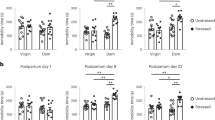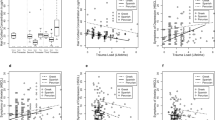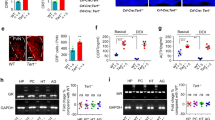Abstract
Depressive symptomatology can proceed from altered hypothalamic-pituitary-adrenocortex (HPA)-axis function. Some authors stress the role that early life stress (ELS) may play in the pathophysiology of depressive symptoms. However, the involvement of the HPA-axis in linking prenatal ELS with depressive symptoms has not been tested in a prospective-longitudinal study extending until after puberty in humans. Therefore, we examined whether antenatal maternal anxiety is associated with disturbances in HPA-axis regulation and whether the HPA-axis dysregulation mediates the association between antenatal maternal anxiety and depressive symptoms in post-pubertal adolescents. As part of a prospective-longitudinal study, we investigated maternal anxiety at 12–22, 23–32, and 32–40 weeks of pregnancy (wp) with the State Trait Anxiety Inventory (STAI). In the 14–15-year-old offspring (n=58) HPA-axis function was measured through establishing a saliva cortisol day-time profile. Depressive symptoms were measured with the Children's Depression symptoms Inventory (CDI). Results of regression analyses showed that antenatal exposure to maternal anxiety at 12–22 wp was in both sexes associated with a high, flattened cortisol day-time profile (P=0.0463) which, in female adolescents only, was associated with depressive symptoms (P=0.0077). All effects remained after controlling for maternal smoking, birth weight, obstetrical optimality, maternal postnatal anxiety and puberty phase. Our prospective study demonstrates, for the first time, the involvement of the HPA-axis in the link between antenatal maternal anxiety/prenatal ELS and depressive symptoms for post-pubertal female adolescents.
Similar content being viewed by others
Log in or create a free account to read this content
Gain free access to this article, as well as selected content from this journal and more on nature.com
or
References
Angold A, Costello EJ, Worthman CM (1998). Puberty and depression: the role of age, pubertal status and pubertal timing. Psychol Med 28: 51–61.
Baron RM, Kenny DA (1986). The moderator-mediator variable distinction in social psychological research: Conceptual, strategic, and statistical considerations. J Pers Soc Psychol 51: 1173–1182.
Beardslee WR, Gladstone TRG (2001). Prevention of childhood depression: recent findings and future prospects. Biol Psychiat 49: 1101–1110.
Claes SJ (2004). CRH, stress, and major depression: a psychobiological interplay. Vitam Horm 69: 117–150.
Claes SJ, Nemeroff CB (2005). Corticotrophin-releasing factor (CFR) and major depression: towards an integration of psychology and neurobiology in depression research. In: Corveleyn J, Luyten P, Blatt SJ (eds). The Theory and Treatment of Depression. Towards a Dynamic Interactionism Model. University Press: Leuven, Belgium and Erlbaum, Mahwah, NJ. pp 227–252.
Coe CL, Kramer M, Czeh B, Gould E, Reeves AJ, Krischbaum C et al (2003). Prenatal stress diminishes neurogenesis in the dentate gyrus of juvenile rhesus monkeys. Biol Psychiatry 54: 1025–1034.
Cohen J, Cohen P (1983). Applied Multiple Regression/Correlation Analysis for the Behavioral Sciences, 2nd edn. Erlbaum: Hillsdale.
Chrousos GP (1998). Stressors, stress and the neuroendocrine integration of the adaptive response. Ann NY Acad Sci 851: 311–335.
Chrousos GP, Charmandari E, Kino T (2004). Editorial: Glucorticoid action networks—an introduction to systems biology. J Clin Endocrinol Metabol 89: 563–564.
Chrousos GP, Gold PW (1998). Editorial: A health body in a healthy mind-and vice versa-the damaging power of ‘uncontrollable stress’. J Clin Endocrinol Metabol 56: 1842–1845.
Davis EP, Glynn LM, Dunkel Schetter C, Hobel C, Chicz-Demet A, Sandma CA (2005). Corticotropopin-relasing hormone during pregnancy is associated with infant temperament. Dev Neurosci 27: 299–305.
de Kloet ER, Sibug RM, Helmerhorst FM, Schmidt M (2005). Stress, genes and the mechanism of programming the brain for later life. Neurosci Biobehav Rev 29: 271–282.
den Hartog HM, Nicolson NA, Derix MMA, van Bemmel AL, Kremer B, Dolles J (2003). Salivary cortisol patterns and cognitive speed in major depression: a comparison with allergic rhinitis and healthy control subjects. Biol Psychiatry 63: 1–14.
Deuschle M, Schweiger UL, Weber B, Gotthardt U, Körner A, Schmider J et al (1997). Diurnal activity and pulsatility of the hypothalamus-pituitary-adrenal system in male depressed patients and healthy controls. J Clin Endocrinol Metabol 82: 234–238.
Edwards S, Clow A, Evans P, Hucklebridge F (2001). Exploration of the awakening cortisol response in relation to diurnal cortisol secretory activity. Life Sci 68: 2093–2103.
Egliston K-A, McMahon C, Austin M-A (2007). Stress in pregnancy and infant HPA axis function: conceptual and methodological issues relating to the use of salivary cortisol as an outcome measure. Psychoneuroendocrinology 32: 1–13.
Federman DD (2006). The biology of human sex differences. N Eng J Med 354: 1507–1514.
Forbes EE, Williamson DE, Ryan DN, Birmaher B, Axelson DA, Dahl RE (2006). Peri-sleep-onset cortisol levels in children and adolescents with affective disorders. Biol Psychiatry 59: 24–30.
Friedman L, Wall M (2005). Graphical views of suppression and multicollinearity in multiple linear regression. American Statistician 59: 127–136.
Ge X, Natsuaki MN, Conger RD (2006). Trajectories of depressive symptoms and stressful life events among male and female adolescents in divorced and nondivorced families. Dev Psychopathol 18: 253–274.
Gluckman PD, Hanson MA (2004). Living with the past: evolution, development and patterns of disease. Science 305: 1733–1736.
Goodyer IM, Herbert J, Tamplin A, Altham PME (2000). Recent life events, cortisol, dehydroepiandrosterone and the onset of major depression in high-risk adolescents. Br J Psychiatry 177: 499–504.
Gottesman I, Gould T (2003). The endophenotype concept in psychiatry: etymology and strategic intentions. Am J Psychiatry 160: 1–10.
Gunnar MR, Vazquez DM (2001). Low cortisol and a flattening of expected daytime rhythm: potential indices of risk in human development. Dev Psychopathol 13: 515–538.
Gunnar M, Quevedo K (2007). The neurobiology of stress and development. Annu Rev Psychol 58: 145–173.
Gütteling BM, de Weerth C, Buitelaar JK (2005). Prenatal stress and children's cortisol reaction to the first day of school. Psychoneuroendocrinology 30: 541–549.
Halbreich U (2006). Major depression is not a diagnosis, it is a departure point to differential diagnosis-clinical and hormonal considerations. Psychoneuroendocrinology 31: 16–22.
Halligan SL, Herbert J, Goodyer IM, Murray L (2004). Exposure to postnatal depression predicts elevated cortisol in adolescent offspring. Biol Psychiatry 55: 376–381.
Halligan SL, Herbert J, Goodyer I, Murray L (2006). Disturbances in morning cortisol secretion in association with maternal postnatal depression predict subsequent depressive symptomatology in adolescents. Biol Psychiatry 60 (in press) doi: 10.1016/j.biopsych.2006.09.011.
Hankin BL (2006). Adolescent depression: description, causes and intervention. Epilepsy Behav 8: 102–114.
Hankin BJ, Abramson LV (2001). Development of gender differences in depression: an elaborated cognitive vulnerability-transactional stress theory. Psycholog Bull 127: 773–796.
Heim C, Ehlert U, Hellhammer D (2000). The potential of hypocortisolism in the pathophysiology of stress-related bodily disorders. Psychoneuroendocrinology 25: 1–35.
Heim C, Plotsky PM, Nemeroff CB (2004). Importance of studying the contributions of early adverse experience to neurobiological findings in depression. Neuropsychopharmacology 29: 641–648.
Holsboer F (2001). Stress, hypercortisolism and corticosteroid receptors in depression: implications for therapy. J Affect Disord 62: 77–91.
Holsboer F, Bardeleben U, Gerken A, Stalla GK, Muller OA (1984). Blunted corticotropin and normal cortisol response to corticotropin-releasing-factor in depression. Engl J Med 311: 1127.
Huizink AC, Mulder EJH, Buitelaar JK (2004). Prenatal stress and risk for psychopathology: specific effects or induction of general susceptibility? Psychol Bull 130: 115–142.
Kajantie E (2006). Fetal origins of stress-related adult disease. Ann NY Acad Sci 1083: 11–27.
Kajantie E, Phillips DIW (2005). The effects of sex and hormonal status on the physiological response to acute psychosocial stress. Psychoneuroendocrinology 31: 151–178.
Kaufman J, Charney D (2001). Effects of early stress on brain structure and function: implications for understanding the relationship between child maltreatment and depression. Dev Psychopathol 13: 451–471.
Kessler RC (2003). Epidemiology of women and depression. J Affect Disorders 74: 5–13.
Kreider ML, Tata CA, Cousins MM, Olier CA, Seidler FJ, Slotkin TA (2006). Lasting effects of developmental dexamethasone treatment on neural cell number and size, synaptic activity and cell signaling: critical periods of vulnerability, dose-effect relationships, regional targets and sex selectivity. Neuropsychopharmacology 31: 12–35.
Kovacs M (1992). Children's Depression Inventory. Multi Health Systems: New York.
Ladd CO, Huot RL, Thrivikraman KV, Nemeroff CB, Meaney MJ, Plotsky PM (2000). Long-term behavioral and neuroendocrine adaptations to adverse early experiences. Progr Brain Res 122: 81–103.
Levine S (2005). Developmental determinants of sensitivity and resistance to stress. Psychoneuroendocrinology 30: 939–946.
Maccari S, Darnaudery M, Morley-Fletcher S, Zuena AR, Cinque C, Van Reeth O (2003). Prenatal stress and long-term consequences: implications of glucocorticoid hormones. Neurosci Biobehav Rev 27: 119–127.
MacKinnon DP, Lockwood CM, Williams J (2004). Confidence limits for the indirect effect: distribution of the product and resampling methods. Multivar Behav Res 39: 99–128.
Macri S, Spinelli S, Adriani W, Highley JD, Laviola G (2007). Early adversity and alcohol availability persistently modify serotonin and hypothalamic-pituitary-adrenal-axis metabolism and related behavior: what experimental research on rodents and primates can tell us. Neurosci Biobehav Rev 31: 172–180.
McBruce BS, Wingfield JC (2003). The concept of allostasis in biology and biomedicine. Horm Behav 43: 2–15.
McEwen BS (2002). Sex, stress and the hippocampus: allostasis, allostatic load and the aging process. Neurobiol Aging 23: 921–939.
Meaney MJ, Szyf M (2005). Environmental programming of stress responses through DNA methylation: Life at the interface between dynamic environment and a fixed genome. Dialogues in Clinical Neuroscience 7: 103–123.
Netherton C, Goodyer J, Tamplin A, Herbert J (2004). Salivary cortisol and dehydroepiandrosterone in relation to puberty and gender. Psychoneuroendocrinology 29: 125–140.
Miller GE, Chen E, Zhou ES (2007). If it goes up, must it comd down? Chronic stress and thet hypothalamic-puitary-adrenocortical axis in humans. Psychol Bull 113: 25–45.
O'Connor TG, Ben-Shlomo Y, Heron J, Golding H, Adams D, Glover V (2005). Prenatal anxiety predicts individual differences in cortisol in pre-adolescent children. Biol Psychiatry 58: 211–217.
O'Connor TG, Heron J, Golding J, Glover V (2003). Maternal antenatal anxiety and behavioural/emotional problems in children: a test of a programming hypothesis. J Child Psychol Psychiatry 44: 1025–1036.
Ong SH, Wickramatne P, Tang M, Weissman MM (2006). Early childhood sleep and eating problems as predictors of adolescent mood and anxiety disorders. J Affect Disord 96: 1–8.
Owen D, Andrews MH, Matthews EJH (2005). Maternal adversity, glucocorticoids and programming of neuroendocrine function and behaviour. Neurosci Biobehav Rev 29: 209–226.
Peeters F, Nicolson N, Berkhof J (2004). Levels and variability of daily life cortisol secretion in major depression. Psychiatry Res 126: 1–13.
Phillips DI (2004). Fetal programming of the neuroendocrine response to stress: links between low birth weight and the metabolic syndrome. Endocr Res 30: 819–826.
Pruessner JC, Wolf OT, Hellhammer DH, Buske-Kirschbaum A, von Auer K, Jobst S et al (1997). Free cortisol levels after awakening: a reliable biological marker for the assessment of adrenocortical activity. Life Sci 61: 2539–2549.
Pruessner M, Hellhammer DH, Pruessner JC, Lupien SJ (2003). Self-reported depressive symptoms and stress levels in healthy young men: associations with the cortisol response to awakening. Psychosom Med 65: 92–99.
Raison CL, Miller AH (2003). When not enough is too much: the role of insufficient glucocorticoid signaling in the pathophysiology of stress-related disorders. Am J Psychiatry 160: 1554–1565.
Rodriguez A, Bohlin G (2005). Are maternal smoking and stress during pregnancy related to ADHD symptoms in children. J Child Psychol Psychiatry 46: 246–254.
Rosmond R, Dallman MF, Björntorp P (1998). Stress-related cortisol secretion in men: relationships with abdominal obesity and endocrine, metabolic and hemodynamic abnormalities. J Clin Endocrinol Metabol 83: 1853–1859.
Sachar E, Hellman L, Fukushima DK, Gallagher TE (1970). Cortisol productionin depressive illness. Arch Gen Psyhiatry 23: 289–298.
Swaab DW, Bao A-M, Lucassen PJ (2006). The stress system in the human brain in depression and neurodegeneration. Ageing Res Rev 4: 141–194.
Talge NM, Neal C, Glover V, and the Early Stress, Translational Research and Prevention Science Network (2007). Fetal and neonatal experience on child and adolescent mental health. Antenatal maternal stress and long-term effects on child neurodevelopment: how and why? J Child Psych Psychiatry 48: 245–261.
Tanner JM (1962). Growth at Adolescence: with a General Consideration of the Effects of Heridity and Environmental Factors upon Growth and Maturation from Birth to Maturity. Blackwell Scientific Publications: Oxford.
Tarullo AR, Gunnar MR (2006). Child maltreatment and the developing HPA axis. Horm Behav 50: 632–639.
Timbremont B, Braet C (2002). Manual for the Dutch Children's Depression Inventory. Swets & Zeitlinger: Lisse, the Netherlands.
Thompson C, Syddall H, Rodin I, Osmond C, Barker DJP (2001). Birth weight and the risk of depressive disorder in late life. Brit J Psychiat 179: 450–455.
Van den Bergh BRH (1992). Maternal emotions during pregnancy and fetal and neonatal behaviour. In: Nijhuis JG (ed). Fetal Behaviour. Developmental and Perinatal Aspects. Oxford University Press: Oxford, UK. pp 157–174.
Van den Bergh BRH, Marcoen A (2004). High antenatal maternal anxiety is related to ADHD symptoms, externalizing problems and anxiety in 8/9-year-olds. Child Dev 75: 1085–1097.
Van den Bergh BRH, Mulder EJH, Mennes M, Glover V (2005a). Antenatal maternal anxiety and stress and the neurobehavioral development of fetus and child: links and possible mechanisms. A review Neurosci Biobehav Rev 29: 237–258.
Van den Bergh BRH, Mennes M, Oosterlaan J, Stevens V, Stiers P, Marcoen A et al (2005b). High antenatal maternal anxiety is related to impulsivity during performance on cognitive tasks in 14- and 15-year-olds. Neurosci Biobehav Rev 29: 259–269.
Van den Bergh BRH, Mennes M, Stevens V, van der Meere J, Börger N, Stiers P et al (2006). ADHD deficit as measured in adolescent boys with a continuous performance task is related to antenatal maternal anxiety. Pediatric Research 59: 78–82.
Van Den Eede F, Van Broeckhoven C, Claes SJ (2005). Corticotropin-releasing factor-binding protein, stress and major depression. Ageing Res Rev 4: 213–239.
Van der Ploeg HM, Defares PB, Spielberger CD (1980). Manual of the Self-Evaluation Questionnaire: a Dutch Version of the State-Trait Anxiety Inventory. Swets & Zeitlinger: Lisse, the Netherlands.
van Praag HM, de Kloet ER, van Os J (2004). Stress, the Brain and Depression. Cambridge University Press: Cambridge.
van West D, Van Den Eede F, Del-Favero J, Souery D, Norrback K-F, Van Duijn C et al (2006). Glucocorticoid receptor gene-based SNP analysis in patients with recurrent major depression. Neuropsychopharmacology 31: 620–627.
Weaver ICG, La Plante P, Weaver S, Parent A, Sharma S, Diorio J et al (2001). Early environmental regulation of hippocampal glucocorticoid receptor gene expression: Characterization of intracellular mediators and potential genomic target sites. Mol Cell Endocrinol 185: 205–218.
Weaver ICG, Champagne FA, Brown SE, Dymov S, Sharma S, Meaney MJ et al (2005). Reversal of maternal programming of stress responses in adult offspring through methyl supplementation: altering epigenetic marking later in life. J Neurosci 25: 11045–11054.
Welberg LAM, Seckl JR (2001). Prenatal stress, glucocorticoids and the programming of the brain. J Neuroendocrinol 13: 113–128.
Wüst S, Federenko I, Hellhamer DH, Kirschbaum C (2000). Genetic factors, perceived chronic stress, and the free cortisol response to awakening. Psychoneuroendocrinology 25: 707–720.
Young EA, Vazquez D, Jiang H, Pfeffer CR (2006). Saliva cortisol and response to dexamethasone in children of depressed parents. Biol Psychiatry 60: 831–836.
Acknowledgements
We are extremely grateful to all families who took part in this study, to Vivette Glover, perinatal psychobiologist, who gave advice in collecting the saliva samples and had the samples analyzed in her lab, to Johan Wagemans, for useful comments on the previous draft of the manuscript, experimental psychologist to the psychologists who collected the data (Veerle Stevens, Tanja Geerdens) entered the data (Ann Theunissen) and searched relevant literature (Sylvia Pinna Puissant). This research is supported by Grant no G.0211.03 of the Fund for Scientific Research—Flanders (Belgium), by IUAP P06/04 (DYSCO) GOA-AMBioRICS, EU projects BIOPATTERN (FP6-2002-IST 508803) and eTUMOUR (FP6-2002-LIFESCIHEALTH 503094) and by grants IMPH/06/GHW and IDO 05/010 EEG-fMRI of the Katholieke Universiteit Leuven (KU Leuven).
Author information
Authors and Affiliations
Corresponding author
Additional information
DISCLOSURE/CONFLICT OF INTEREST
None of the authors has a potential conflict of interest. None of them has received a compensation for professional services in any of the previous three years, or anticipates receiving such compensation in the near future.
Rights and permissions
About this article
Cite this article
Van den Bergh, B., Van Calster, B., Smits, T. et al. Antenatal Maternal Anxiety is Related to HPA-Axis Dysregulation and Self-Reported Depressive Symptoms in Adolescence: A Prospective Study on the Fetal Origins of Depressed Mood. Neuropsychopharmacol 33, 536–545 (2008). https://doi.org/10.1038/sj.npp.1301450
Received:
Accepted:
Published:
Issue date:
DOI: https://doi.org/10.1038/sj.npp.1301450
Keywords
This article is cited by
-
Prenatal programming of environmental sensitivity
Translational Psychiatry (2023)
-
Associations Between Maternal Stressful Life Events and Perceived Distress during Pregnancy and Child Mental Health at Age 4
Research on Child and Adolescent Psychopathology (2022)
-
Breast may not always be best: moderation of effects of postnatal depression by breastfeeding and infant sex
Biology of Sex Differences (2021)
-
Altered hypothalamic DNA methylation and stress-induced hyperactivity following early life stress
Epigenetics & Chromatin (2021)
-
Prenatal stress effects on offspring brain and behavior: Mediators, alterations and dysregulated epigenetic mechanisms
Journal of Biosciences (2021)



